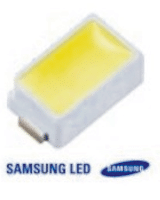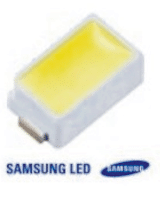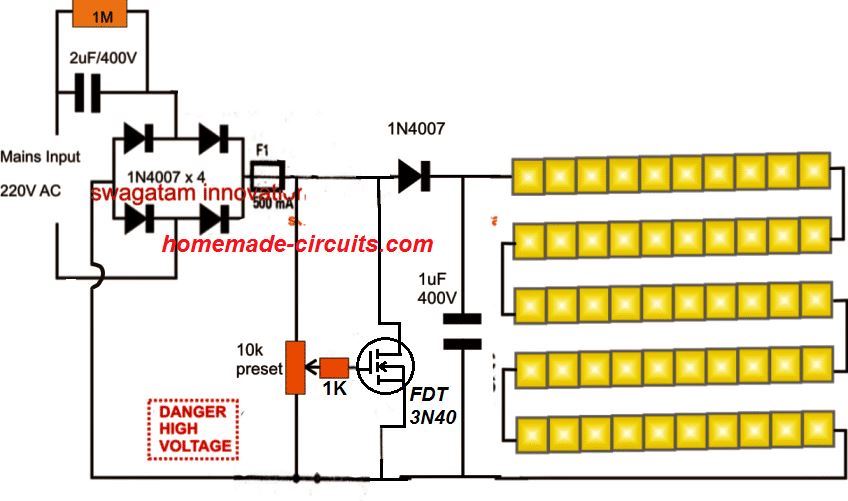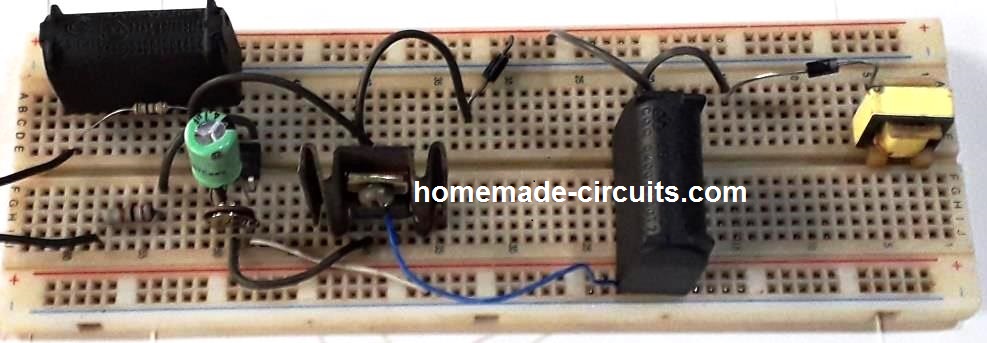
In this post I have explained a simple transformerless SMD 5630 type LED tube light circuit which can be built by anybody for illuminating home interior cheaply. The idea was requested by Mr. Smeet.
Technical Specifications
I am a very big fan of your website and it has been much helpful to me in my college projects i wanted to design a driver to drive 1 to 50 SMD 5630 LE and input voltage 110 to 235 v , forward voltage of LED is 3.3v and i need a very efficient circuit i.e all LED should be maximum brigh would u please help us with this circuitlooking forward to your reply soon
thank you
The Design
The LED model shown below is the 5630 type surface mount LED from Samsung which has the following typical voltage and current specifications:
Forward voltage: 3.3V
Optimal Current: Between 50 and 150mA
Power dissipation: 0.5 watts approximate.

Although it is recommended to operate any LED via a current controlled SMPS, for simplicity sake the following compact transformerless power supply may be tried and could prove as good as it's other counterparts.
The present design is based on my previous variable transformerless power supply design, which enjoys a novel crowbar network concept for safeguarding the involved sophisticated devices.
The proposed 5630 SMD LED driver or compact tube light circuit may be understood with the help of the following discussion:
Circuit Operation
The input capacitor which is a high voltage metalized polyester 2uF/400V rated capacitor drops the mains 220v to desirable limits and feeds the connected the bridge rectifier stage.
The bridge rectifier in conjunction with the 1uF/400V rectifies the AC into a 330V DC.
This high DC is applied across the crowbar network comprising the zener, MOSFET and the preset in the stage.
The preset is appropriately set such that the the output matches the total forward drop of the connected LEDs.
If 50 LEDs are connected in series at the output the above preset must be selected to produce precisely a voltage of around 50 x 3.3 = 165V
Once set, this voltage gets clamped and never exceeds even under worse conditions.
The LEDs thus stay safeguarded from all possible high voltage and surge current hazards.
This happens owing to the fact that the mosfet tends to conduct and ground the output voltage whenever the voltage across its drain/source tries to rise above the set value which may be 165V as assumed here.
Other different number of LEDs may be opted for at the output as per individual preferences, and the preset set up as per the calculations discussed above.
In the shown circuit diagram all the LEDs are connected in series to form a chain of 50 LEDs connected one behind the other with anode of one LED connected to the cathode of the other, and so on.
NOTE: Please connect a 50 Ohm / 1 watt resistor in series with the LED chain for better safety of the LEDs
Circuit Diagram
THE WHOLE CIRCUIT WOULD BE FLOATING WITH LETHAL MAINS AC, EXTREME CAUTION IS EXPECTED FROM THE USER WHILE TESTING THE CIRCUIT IN AN UNCOVERED POSITION.

Feedback from one of the dedicated readers of this blog, Mr. Raghavendra Kolkar:
Hello sir good evening, thanks a lot for sending the circuit diagram of led driver. After 5 failures finally the circuit was successful.
I am sending you the picture of the driver and working.
Thanks a lot, so far all your circuits are working well and nice.




With over 50,000 comments answered so far, this is the only electronics website dedicated to solving all your circuit-related problems. If you’re stuck on a circuit, please leave your question in the comment box, and I will try to solve it ASAP!